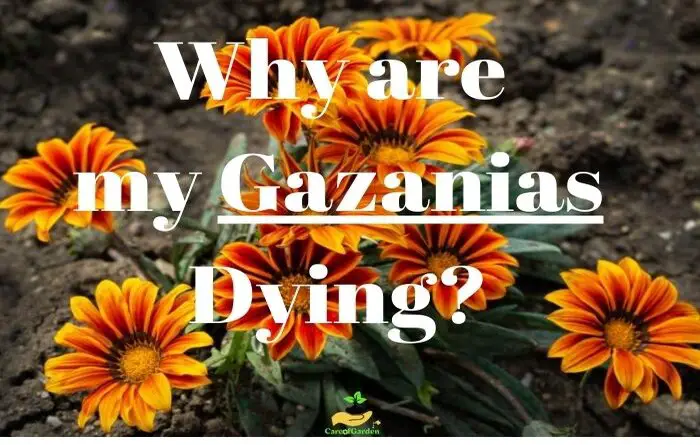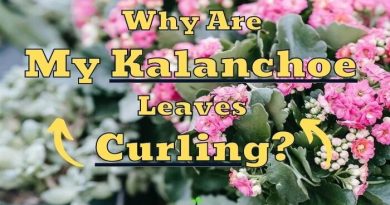Top 5 Reasons Why Gazanias Are Dying
Gazanias (African daisies) are one of the most popular garden plants, prized for their bright, cheerful blooms and easy maintenance. However, if you’re finding that your once-vibrant gazanias are now wilting and dying, it can be frustrating. In this blog post, we will answer this question: why are gazanias dying, and offer solutions and advice for keeping these beautiful plants healthy and thriving.
Gazanias can die for several reasons, including over-watering, under-watering, lack of sunlight, disease, pests, and improper soil conditions. It’s important to understand the specific needs of your gazanias and provide proper care, such as adequate water, sunlight, and well-drained soil. Regular monitoring for signs of disease or pests and taking prompt action can also help prevent gazanias from dying.
Why Are My Gazanias Dying?
It could be due to a number of reasons that your Gazanias are dying. Like pests and diseases, incorrect use of water, soil, or fertilizers, and even inappropriate care for the plant.
When you are growing the plant it is very important to look for the signs.
Any sort of wilting of leaves should mean that you need to check the soil or the water level in the plant. Incorrect soil type, and under or over-watering can be the causes of this issue.
Color changing of the leaves is largely due to diseases or infestations as well as incorrect growth environment. Notice the signs and follow the solutions we’ve mentioned to take charge of the situation.
1. Incorrect Type of Soil
Gazanias are tough plants that can grow in a range of soil conditions, but proper soil conditions are crucial for the health and survival of your gazanias. If your Gazanias are dying you might have to look at where you have planted them.
Check if the soil quality has gotten poor over time. It may mean that any addition of fertilizers might have changed the PH level. If the soil has gotten too acidic it will affect plant growth. A simple test at home can help you determine your soil PH.
Moreover, check your plant pot to see if it has proper draining holes. Tightly compact soil can also be an issue.
Solution
In order to test for acidity, Simply take 2 tbsp of soil and add 1 tbsp of distilled water. Add around ½ cup of baking soda. If the mixture fizzes up then you have acidic soil.
Change the soil in this case or add some agriculture limestone to counter the PH.
Gazanias thrive in soil that is neutral to alkaline. Even if it goes mildly acidic, the plant begins to show signs of unrest and you can start losing leaves shortly.
Furthermore, ensure that the soil is airy and sandy and the pot has enough drainage holes so that it does not become waterlogged or nutrient-rich.
2. Pests and Fungal Attacks
Gazanias or commonly know African daisies are no strangers to frequent pest and fungal attacks. Some of the common ones are Downy Mildew, Aphids, Mealybugs, Spider mites, Botrytis and Powdery Mildew.
Infestations of pests and the onset of diseases can cause significant harm to your gazanias, leading to stunted growth, wilted leaves and eventually death.
The most obvious indication of a pest attack is the color change in the leaves. Usually, they turn white, but in some cases, they can turn yellow or brown as well. In case the plant shows any of these issues checking for pests should be the first step.
Powdery mildew
Powdery mildew is one of the most common fungal diseases in gazanias, but is much less dangerous than most other variants. It can be recognized externally by the whitish coating that can be found on the leaves.
Severe infestations with powdery mildew can lead to leaf fall and death of gazania flowers. Powdery mildew is a so-called fair-weather fungus and gazanias are particularly susceptible in phases with very dry air. Even soil moisture and vital plants are important.
With organic plant treatments you can protect Gazania against infestation with powdery mildew.
When the first infestation occurs, you can remove the affected leaves and dispose of them with household waste. The infestation can be contained with special pesticides. However, it is always necessary to weigh the costs and benefits.
Do not place the plants too close together and pay attention to a sunny location.
Gray mold
The presence of gray mold can be identified by the presence of gray-coated leaves. Over time, the underlying tissue dies, and prominent red-brown blotches appear on the gazanias leaves.
The upper leaves begin to shrink and finally fall off. Gazanias are frequently so affected by gray mold infestations that the entire flower dies.
Infection with gray rot mainly occurs on weakened and injured plants, as they have very little resistance to diseases and pests. Gazanias plants that are too close together, as well as plants in locations with little light, are often affected by an infestation of gray mold.
If you notice gray mold, you should remove diseased parts of the plant immediately. To do this, cut the affected areas back to the healthy tissue with sharp pruning shears. Thoroughly disinfect all work materials after the work is done.
Aphids
Aphids are a very common insect pest that feeds on the sap of young gazanias. Plants infected with aphids weaken, stop blooming and can easily die.
Infestation by aphids or mites is mainly observed in Gazanias that are transplanted to an unsuitable location and therefore have a lower self-protection effect against pests. Even if the pests themselves are difficult to see with the human eye, the effects of inadequate treatment are often fatal.
If this pest appears in the flower garden, it can be washed off the flowers with water. But here you need to act carefully, because you could harm the plant itself. In general, in order to prevent the appearance of aphids on the site, onions and garlic are planted between Gazanias – the smell repels insects.
Snails and slugs
Especially in spring, when the first tender leaves appear, snails will feast on Gazanias and cause considerable damage in the process. By eating the Gazanias leaves, the plants become bare and as a result die.
These pests are best removed from flower beds by hand. In addition, many birds feed on them – they will help save the Gazania.
Therefore, instead of the widespread destruction of snails and slugs, it is better to protect the Gazanias from them – to set traps, sprinkle the space between the beds with gravel, crushed shells or eggshells.
Solution
Ideally, you should regularly check under the leaves and in any nooks and crannies for any sort of bug infestation. Humidity breeds bacteria, fungi, and insects so ensure that the surrounding environment is not extremely humid for the plant.
To counteract issues that the bug infestation may cause, apply an insecticide like neem oil throughout the surface of the plant.
For any other type of fungal issue, use a chemical-free insect repellant that will not harm the plant. Furthermore, prune any leaves that are beyond the damage and have too much infestation.
This is to ensure all the nutrients in the plants are directed towards the healthy growing parts and that the fungus or pests do not spread.
3. Excess Use of Water
Oxygen is extremely important for plants to carry out photosynthesis. If you are providing excess water to the Gazanias plant, the soil can become waterlogged.
This easily forms a barrier around the roots preventing oxygen to penetrate through. No photosynthesis means no food which eventually leads to the Gazanias dying.
These plants can easily survive a short-term drought. Meaning they do not need to be watered excessively. You should only water the plant if the soil is dry, usually 1-2 times a week in summer and maybe once a month in winter.
It doesn’t like waterlogged soils, so the ideal would be to water it first thing in the morning and let the substrate evaporate during the day. Even so, it does not suffer if it is watered at night either.
But it is important that water does not accumulate and that it does not receive more watering than is necessary.
It should also be noted that, in order to achieve continuous flowering, all the flowers that have withered must be removed. If they are left, the plant will spend a lot of effort generating seeds.
Solution
When you are potting your plant, make sure it has enough drainage holes for the water to pass through easily. You should put a circular plate underneath the pot.
Whenever you water the plant check and discard any excess water after 10 minutes to avoid root rot.
Stick to a schedule when it comes to watering. If you live in a warmer climate, water every 2-3 days. Check to make sure the soil is dry.
If you see that you have overwatered the plant stop immediately. Keep the plant out in the sun so it dries more to avoid any further side effects.
If your leaves start to wilt, it might mean you are under watering the plant. In this case, just make sure you are slowly adding the water and not dumping huge amounts on the plant as it can cause the soil to become waterlogged.
By following these few tips you can effectively water your Gazanias without causing any damage.
4. Lack of water
Gazanias can grow in almost any environment, but they require adequate watering to remain healthy. Unfortunately, one of the main reasons why Gazanias die is due to lack of water (under-watering). If the leaves are wilting but the soil isn’t dry, the plant may not be getting enough water.
The first symptoms for lack of water are leaves will begin to wilt and the blooms will start to fade. Also the leaves should feel plump and firm, not soft or mushy. If the leaves have taken on a yellow or brown color, it may also be a sign of under-watering.
To avoid under-watering, you require to understand your Gazanias’ specific needs: In general, depending on the weather and soil conditions, Gazanias should be watered once or twice a week. It’s time to water if the soil is dry. It’s best to wait if the soil is still damp.
Solution
Gazanias can protect itself from a lack of moisture because of its long roots, are able to get water from the soil, and the fluff on the leaves prevents excessive evaporation of water.
Gazanias planted in the ground are satisfied with rainwater but, in periods of prolonged drought and in summer, they must be watered regularly.
When the soil dries, you need to moisten the Gazanias. But you should not allow a long drought, this adversely affects flowering. When watering, it is better not to fall on the leaves
In the summer, in the absence of water, the tuft of leaves collapses until it touches the ground. Watering should be reduced in autumn and completely suspended in winter.
5. Improper Growth Climate
If you notice the plant’s wilting leaves changing color and the issue does not reside in watering or any pest then you may have to rethink the surrounding environmental conditions of the plant itself.
Naturally grown in South Africa, Gazanias are sun-loving plants.
They enjoy a dry climate with bright sunlight. Full direct sunlight actually helps the plant to bloom and if it is placed in shaded areas, its growth can be stunted.
Check if there maybe be more humidity or low temperatures around the plant that might be causing it to die. You also need to ensure that you place them in a well-lit place.
Solution
Reposition where the plant is being kept. Make sure it is not near any humidifier or areas like the washroom or laundry room that are generally more humid than the house.
Keep it near a window where you get the most light throughout the day. The plant will close off its leaves if they notice any shade nearby.
If you notice that the surrounding temperature is low, protect the plant in your garden by covering it in leaf mulch. Furthermore, use artificial means like a heater to warm up the temperature if it is potted indoors.
How to Prevent Gazanias from Dying
To prevent gazanias flowers from dying, you can follow these steps:
- Water Properly: Over-watering or under-watering can cause gazanias to die. Make sure to provide enough water to keep the soil moist, but not waterlogged. Allow the soil to dry out slightly between waterings.
- Provide Adequate Sunlight: Gazanias need at least six hours of direct sunlight per day. If your plants are in a shaded area, they may struggle to produce blooms.
- Use Well-Draining Soil: Poor drainage can lead to root rot, causing gazanias to die. Make sure to plant gazanias in soil that is well-draining, or consider using a raised bed.
- Fertilize Regularly: Gazanias benefit from regular feeding, especially during the growing season. Use a balanced, slow-release fertilizer to provide the necessary nutrients for healthy growth.
- Monitor for Pests and Diseases: Regularly check your gazanias for signs of disease or pests, such as wilting leaves or discolored blooms. If you detect a problem, take prompt action to treat the issue.
- Prune Regularly: Regular pruning can help keep gazanias healthy and prevent them from dying. Cut back spent blooms and yellowing leaves to promote new growth.
| Gazania Care Requirements | Description |
|---|---|
| 1. Water | Gazanias planted in the ground are satisfied with rainwater but, in periods of prolonged drought and in summer, they must be watered regularly. If you grow it in pots , increase the number of waterings to once a week . |
| 2. Sunlight | Sunny with direct sunlight. |
| 3. Fertilizer | Top dressing every 20-25 days during the growing season. |
| 4. Soil pH | Gazania requires a draining but fertile soil rich in organic matter with a neutral pH. |
| 5. Temperature | Range of 75°F-86°F (24-30°C). |
| 6. Humidity | The range is between 40-75%. |
| 7. Pruning | Annually in the spring. Pruning as the inflorescences and leaves of the plant dry. |
| 8. Pests | Greenhouse aphids, thrips, mealybugs, spider mites. |
| 9. Diseases | Gray rot, bacterial infections, fungal infection of the root system. |
| 10. Spacing | 20 to 25cm. |
| 11. Planting depth | 1 cm cover of the seedling with refined soil. |
Conclusion
In conclusion, the reasons why gazanias might die vary from over-watering to disease and pests.
It is critical to understand your Gazanias’ growing requirements and to give them suitable care, such as enough water, sunshine, and well-drained soil.
Regularly checking for signs of disease or pests and acting quickly can also help keep Gazanias alive.
Frequently Asked Questions
Immerse the gazanias for at least thirty minutes in water at room temperature, until bubbles appear on the surface. Then transplant it back into the pot, clean the dry leaves and place it in a shady place, away from the sun’s rays.
The climate should be mild but it resists sporadic frosts down to -5ºC. Irrigation must be frequent in summer, but without flooding, to which fertilizer can be added during the flowering season every fortnight. It is a plant that does not grow very tall, about 30 centimeters tall.
The plant flowers only once, although the flowering period lasts between three and six months.
The soil for the gazania should be nutrient-rich and permeable, because the summer flower only tolerates moderate moisture. When cultivating in pots or tubs, you should always work some sand into the potting soil and ensure adequate drainage.




